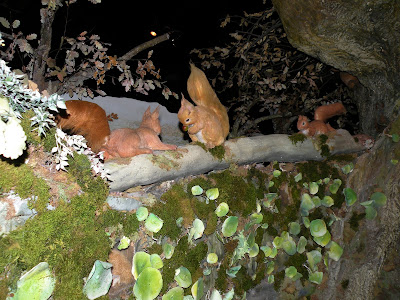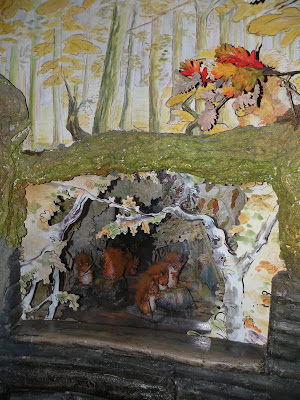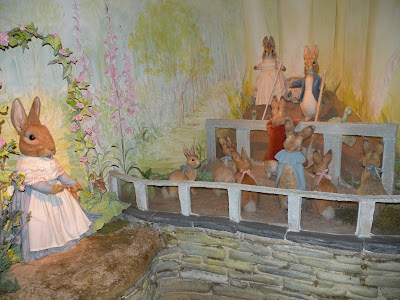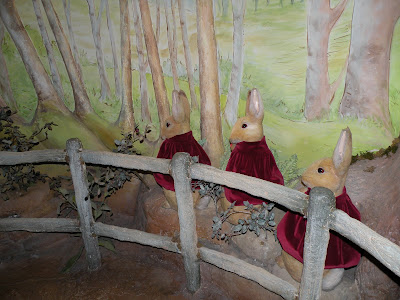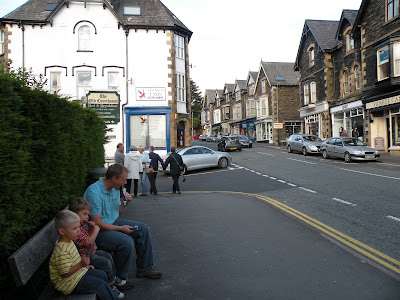
 Good Morning Friday
Good Morning Friday We left Moffat before the park was open, otherwise it would have been fun to take the boys on a swan boat.
We left Moffat before the park was open, otherwise it would have been fun to take the boys on a swan boat.Caerlaverock Castle
 Being that this siege was one of the best-documented, there is a display that explains how this, a typical medieval siege, was carried out. I'm copying the display plaques for those interested - quotes from 'The Song of Caerlaverock' are in italics.
Being that this siege was one of the best-documented, there is a display that explains how this, a typical medieval siege, was carried out. I'm copying the display plaques for those interested - quotes from 'The Song of Caerlaverock' are in italics.
Gathering Forces


 The boys traced and decorated their own shields.
The boys traced and decorated their own shields.


 We explored our last castle of the trip.
We explored our last castle of the trip.
 A full-scale replica trebuchet.
A full-scale replica trebuchet.
King Edward I of England led an army of over 3,000 soldiers to Scotland, and in July they arrived at Caerlaverock. The English set up an enormous camp outside the castle walls and threatened to destroy the castle if the garrison inside didn't surrender. Despite a strenuous effort to repel the attackers, the castle fell after a short time. When the gates were opened it came as some surprise to Edward's army that Caerlaverock was being defended by only 60 men. Most were freed, but some were hanged from the castle walls.
A herald in the English army described the siege in a long poem, called 'The Song of Caerlaverock'. This means that the siege of Caerlaverock is one of the best documented of its time. We know the names of all 87 English Knights, and even the colours of their shields. Unfortunately, we know nothing about the Scottish garrison inside the castle.'
The boys are standing by some of the trebuchet balls that were hurled at the castle during the siege.
An exerpt from 'The Song of Caerlaverock'
'And with these were other banners, seven-and-eighty, as I reckon, crowding towards Caerlaverock Castle. Not like chess-rook was it taken, but by thrusting lances harried, and by battering engines shaken.
Mighty was Caerlaverock Castle. Siege it feared not, scorned surrender-wherefore came the King in person. Many a resolute defender, well supplied with stores and engines, 'gainst assault the fortress manned. Shield-shaped, was it, corner-towered, gate and draw-bridge barbican'd, strongly walled, and girt with ditches filled with water brimmingly. Ne'er was castle lovelier sited: westward lay the Irish Sea, north a countryside of beauty by an arm of sea embraced. On two sides, whoe'er approached it danger from the waters faced; nor was easier the southward - sea-girt land of marsh and wood; therefore from the east we neared it, up the slope on which it stood.'
 Being that this siege was one of the best-documented, there is a display that explains how this, a typical medieval siege, was carried out. I'm copying the display plaques for those interested - quotes from 'The Song of Caerlaverock' are in italics.
Being that this siege was one of the best-documented, there is a display that explains how this, a typical medieval siege, was carried out. I'm copying the display plaques for those interested - quotes from 'The Song of Caerlaverock' are in italics.Laying Down the Gauntlet
In our Lord's year thirteen-hundred, on St. Johns' day, at Carlisle Edward held great court...
The siege of Caerlaverock took place in the year 1300 during the early years of the Wars of Independence with England. To set the scene, Edward I of England had invaded Scotland in 1296 following King John Balliol's downfall. Edward had not reckoned on the strength of resistance to his claim as overlord and the following year William Wallace fought and won a spectacular victory for the Scots at Stirling Bridge in 1297. Edward retaliated with a major expedition in 1298 and a further campaign was organised in 1300 to subdue Galloway. Galloway was particularly vulnerable as it was located on the Border between the two countries. Caerlaverock Castle was on Edward I's route into Galloway and so became a target. The castle was held by Herbert de Maxwell. The Maxwells had been lords of Caerlaverock since the 1220's. Herbert and his son, John, like many nobles of the time, had at first sworn loyalty to Edward but as the reality of his overlordship dawned they withdrew their allegiance. What follows is not one of the key events in the history of the War of Independence, but one of many such skirmishes which took place during more than thirty years of conflict.
Gathering Forces
...and ordered that all men in little while should prepare to march on Scotland, 'gainst his foemen of the north.
This was a time of feudalism, a political system based on alliances and patronage. A king would make grants of land to a knight in return for military service. this was how armies were raised. If a knight was called to action by his king he would have to be able to provide himself with a horse and the necessary equipment such as a sword, lance or dagger. In addition, he would have needed protection for himself and his horse. At the time of the siege of Caerlaverock knights would have worn chainmail rather than full-plated armour.
Being a knight meant subscription to the 'code of chivalry' which united the nobility of Europe. This was based on the ideals of honour, loyalty, valour and a gallant attitude towards women and the poor. Knights had an international outlook and chivalry formed the framework within which wars were fought throughout Europe. As part of this code, knights were treated differently in warfare. If they were captured in battle they would be held for ransom; indeed this was a lucratice practice. Commoners on the other hand were simply killed.
'Tournaments' were held for knights to practise their skills for the battlefield. These began as a form of training but developed into an occasion for feasting, ceremony and pageantry. Rules developed to limit the loss of life at these events, where jousting was the main attraction.
The knights apart, the majority of an army consisted of infantrymen. In some cases these men would be paid for their service, but in Scotland the 'common army' was made up for the most part of husbandmen or bondmen who would fight for free when called upon to defend their country. We do not know how many men defended the castle at Caerlaverock but outside it 3,000 soldiers were waiting to attack.
Who Was There?
There were richly broidered trappings of silk or satin made, many a lovely lance-head pennon, many a banner proud displayed.
The poem relates that no less than eighty-seven knights and nobles came in support of Edward - they could be recognised because of their distinguishing coats of arms. This was the heyday of the art of heraldry which had first developed for precisely that purpse, to recognise individuals at a distance on the battlefield. The practice of using distinctive emblems or insignia had spread, and by 1300 armoury not only adorned the mounted knight on his shield, lance flags, horse trappings and surcoat but was found on objects in his home and his church.
Through fair days, by easy journeys, moved the host in squadrons four. Hear the roll of the companions, and the banners which they bore. Four squadrons were sent to Caerlaverock led respectively by Henry, Earl of Lincoln, John, Earl of Warren, the King himself, and his son, Prince Edward. Many of the knights whose arms are described in the poem had fought with Edward before. Some like Roger la Warre, had accompanied Edward in his Welsh campaigns, others, like Robert de Tateshall, had been to Gascony[part of France] with the king. Many were already veterans of the Scottish wars. John, Earl of Warren, the leader of the second squadron, for example, had commanded the victorious English army at Dunbar in 1296, whereafter he had been appointed Regent of Scotland. His success was shortlived, however, as he led the English army to defeat at the battle of Stirling the year after.
Through fair days, by easy journeys, moved the host in squadrons four. Hear the roll of the companions, and the banners which they bore. Four squadrons were sent to Caerlaverock led respectively by Henry, Earl of Lincoln, John, Earl of Warren, the King himself, and his son, Prince Edward. Many of the knights whose arms are described in the poem had fought with Edward before. Some like Roger la Warre, had accompanied Edward in his Welsh campaigns, others, like Robert de Tateshall, had been to Gascony[part of France] with the king. Many were already veterans of the Scottish wars. John, Earl of Warren, the leader of the second squadron, for example, had commanded the victorious English army at Dunbar in 1296, whereafter he had been appointed Regent of Scotland. His success was shortlived, however, as he led the English army to defeat at the battle of Stirling the year after.
Preparations for the Fray
Far was heard the horses' neighing; far-flung o'er the hills and vales were the sumpter-beasts and wagons bearing stores and tents in bales.
As with any offensive, extensive preparations were made by Edward's army for the forthcoming siege. A camp had to be prepared for the knights and their men. The arrangements were made by Edward's Marshal who was a high lord charged with logistical duties. Colourful tents were put up, the floors of which were strewn with leaves, herbs and flowers. Imagine what a sight this must have been for the defenders of the castle.
One of the most important people in a siege was the engineer. At Caerlaverock, Master Richard was commissioned by Edward I to make a 'cat', a 'belfry' and a 'battering ram'. These weapons would all be used to weaken the castle itself and those defending it. The engineer held a good deal of responsibility and was often well paid. Materials and specialists, including miners and Master Adam, the carpenter, were brought from Dumfries and Carlisle.
A 'belfry' was a siege tower which had two purposes. Firstly, in its lower part it provided cover for soldiers from the defenders' onslaught as they moved towards the gate, and it also supported the 'battering ram'. This usually consisted simply of a large, heavy object, such as a tree trunk, used by being progressively battered against a door or gateway. Secondly, the upper storey provided a bridge to the defenders' wallhead and could also provide a platform for smaller weapons such as springalds (mechanical cross-bows).
Stone-hurling engines, like the trebuchet, were also present at the siege. They were impressive and expensive to build and were often given names, like 'Brother Robert' mentioned in the poem.
A 'cat', 'sow', 'mouse' or 'weasel' was a mobile shelter built to protect the covert operations of miners. Mines were used to weaken the foundations of walls causing a building to fall down, or to build tunnels whereby soldiers could attack the castle or town from inside. A mine at St. Andrews was built when the castle was under siege in 1546. We have not (as yet) found any archaeological evidence of mining around Caerlaverock.
Let Battle Commence!
Many a resolute defender, well supplied with stores and engines, 'gainst assault the fortress manned.
With the preparations made on both sides, the onslaught began against the eastern gateway. Edward reformed his squadrons into three and the foot-men were sent forward discharging arrows, bolts and stones against the hold but in one short hour were many maimed and wouned, many slain. Horrified, several knights leapt to action, amongst them, Bertram de Montbouchier, Gerard de Gondronville and Robert Willoughby, I saw there, bearing gold and fretty blue. Thomas Richmond advanced to the bridge with a force of lances but was met with a shower of stones; meanwhile Hamsart fought so fierce that fragments of his shield flew in the air.
Reinforcements came, led by the King's son with new-painted shields and splendid, burnished caps. Adam de la Forde led the mining contingent at the wall whilst being bombarded with showering stones like heavy rainfall. As the stones fell they were scooped and cast upwards back into the castle. Still the defenders managed to hold the gatehouse for as one fell out exhausted, to his place another leapt. Stones were relentlessly hurled at the castle - all day long did Brother Robert those within the Castle fret - and three more siege engines were brought in to such devastating effect that neither fort nor tower could withstand their mighty pounding.
The fray continued fiercely all day and night until three o'clock the following day when eventually the defenders could stand it no more and a pennon held aloft, sign that they for peace would parley. Ther surrender was accepted by the King's Constable and Marshall and of all ranks, but sixty left it - marvelled we they were so few.
According to the poem, life and limb the good King spared them, and gave each a garment new. Much as we hope that was true, the short account of the siege in the Lanercost Chronicle relates a more sinister ending to this tale where many of the defenders of the castle were hung. Edward rewarded the castle to one of his nobles. Robert de Clifford who himself had fought at the siege, but it remained in English hands only until 1312."


 The boys traced and decorated their own shields.
The boys traced and decorated their own shields.

 We explored our last castle of the trip.
We explored our last castle of the trip. A full-scale replica trebuchet.
A full-scale replica trebuchet.This modern replica is based on the work of Villard de Honnecourt, a 13th-century French architect. The large bucket-like counterweight alone weighs six tonnes. During tests the engine was able to accurately hurl a 100 kg stone ball over 140 metres. Larger trebuchets would have been able to throw missiles up to 400 metres.
A trebuchet works rather like a see-saw. The long arm was winched down, loaded with a stone ball, and then released - the weight on the short arm providing the force which hurled the missile forward and upwards. An assortment of stone trebuchet balls and iron cannon balls have been found in the grounds of Caerlaverock. Cannons began to replace traditional siege engines in the 14th century.'












 Silas and I had gone into this room before Aaron caught up to us. Birds were swooping, so I told Silas we should leave the room so we didn't get pooped on. We stepped out, then Aaron went in. Silas lost it - he started crying and shouting at Aaron, "COME OUT OF THERE! AARON, COME OUT! YOU'RE GOING TO GET POOPED ON!" This went on for a long time! Aaron got a huge kick out of making Silas so upset, and we thought it was hilarious, so we stepped back, watched, and recorded some of it. It still makes us laugh!
Silas and I had gone into this room before Aaron caught up to us. Birds were swooping, so I told Silas we should leave the room so we didn't get pooped on. We stepped out, then Aaron went in. Silas lost it - he started crying and shouting at Aaron, "COME OUT OF THERE! AARON, COME OUT! YOU'RE GOING TO GET POOPED ON!" This went on for a long time! Aaron got a huge kick out of making Silas so upset, and we thought it was hilarious, so we stepped back, watched, and recorded some of it. It still makes us laugh!



 We went to take a walk through the woods behind the castle. Silas, as usual, lagged behind.
We went to take a walk through the woods behind the castle. Silas, as usual, lagged behind.

 The site of the first Caerlaverock Castle - all that's left is the foundation. Seems they built on muddy ground.
The site of the first Caerlaverock Castle - all that's left is the foundation. Seems they built on muddy ground.
 I thought it was funny that the boys were studying a drop of bird poop, so I took a picture...
I thought it was funny that the boys were studying a drop of bird poop, so I took a picture...
 ...Aaron heard the 'click' and stood up, giving me a look of wonder, "Did you just take a picture of the bird poop?!" When I answered in the affirmative, he said "YUK!" then turned to Daniel as if to tattle on me, "Dad!, Mom just took a picture of bird poop!" then he had a good laugh over it!
...Aaron heard the 'click' and stood up, giving me a look of wonder, "Did you just take a picture of the bird poop?!" When I answered in the affirmative, he said "YUK!" then turned to Daniel as if to tattle on me, "Dad!, Mom just took a picture of bird poop!" then he had a good laugh over it!

 The path through the woods comes out at the impressive back of the castle, so why not take another family picture?
The path through the woods comes out at the impressive back of the castle, so why not take another family picture?

 Silas proved he can run after all - when we told the boys they could finally go play at the playground.
Silas proved he can run after all - when we told the boys they could finally go play at the playground.
 "Look at me, Mom, I'm on a bridge."
"Look at me, Mom, I'm on a bridge."


 This is the first time Moriah has been let loose to play on a playground, so I'm posting all the pictures I took of her discovering the fun (and the taste) of dirt and woodchips.
This is the first time Moriah has been let loose to play on a playground, so I'm posting all the pictures I took of her discovering the fun (and the taste) of dirt and woodchips.











England
 After all that history, I kind of felt like we were moving into enemy territory, so I had to switch my mindset - fastforward into modern times and onto more lighthearted things.
After all that history, I kind of felt like we were moving into enemy territory, so I had to switch my mindset - fastforward into modern times and onto more lighthearted things.
 Ever since watching the movie Miss Potter based on the life of Beatrix Potter (The Tale of Peter Rabbit and many other Tales), I've thought it would be fun to visit The Lake District in England. I hadn't gotten my hopes up - it was Daniel who looked into it when we were planning this trip, saw it was in the North, and said he wanted to take me there. This was worth many years of anniversary gifts!
Ever since watching the movie Miss Potter based on the life of Beatrix Potter (The Tale of Peter Rabbit and many other Tales), I've thought it would be fun to visit The Lake District in England. I hadn't gotten my hopes up - it was Daniel who looked into it when we were planning this trip, saw it was in the North, and said he wanted to take me there. This was worth many years of anniversary gifts!





 We stayed in Bowness on Lake Windermere.
We stayed in Bowness on Lake Windermere.
We got to our B&B in the early afternoon, not really having plans for the day. When Daniel told the owners that we were here because of Beatrix Potter, they recommended we see "The World of Beatrix Potter Attraction" right here in Bowness. This won't interest all of you - of this I am certain. I thoroughly enjoyed it, though!











 'We are still having our 'on-going' struggle with some of natures adversaries. We have used nematodes against the vine weevil. We have used a range of measures to counter the insurgency from slugs - of late we have used a small number of organic slug pellets. I you see a slug please feel free to take it home with you.' The boys would have loved that.
'We are still having our 'on-going' struggle with some of natures adversaries. We have used nematodes against the vine weevil. We have used a range of measures to counter the insurgency from slugs - of late we have used a small number of organic slug pellets. I you see a slug please feel free to take it home with you.' The boys would have loved that.
















 Silas and I had gone into this room before Aaron caught up to us. Birds were swooping, so I told Silas we should leave the room so we didn't get pooped on. We stepped out, then Aaron went in. Silas lost it - he started crying and shouting at Aaron, "COME OUT OF THERE! AARON, COME OUT! YOU'RE GOING TO GET POOPED ON!" This went on for a long time! Aaron got a huge kick out of making Silas so upset, and we thought it was hilarious, so we stepped back, watched, and recorded some of it. It still makes us laugh!
Silas and I had gone into this room before Aaron caught up to us. Birds were swooping, so I told Silas we should leave the room so we didn't get pooped on. We stepped out, then Aaron went in. Silas lost it - he started crying and shouting at Aaron, "COME OUT OF THERE! AARON, COME OUT! YOU'RE GOING TO GET POOPED ON!" This went on for a long time! Aaron got a huge kick out of making Silas so upset, and we thought it was hilarious, so we stepped back, watched, and recorded some of it. It still makes us laugh!


 We went to take a walk through the woods behind the castle. Silas, as usual, lagged behind.
We went to take a walk through the woods behind the castle. Silas, as usual, lagged behind.
 The site of the first Caerlaverock Castle - all that's left is the foundation. Seems they built on muddy ground.
The site of the first Caerlaverock Castle - all that's left is the foundation. Seems they built on muddy ground. I thought it was funny that the boys were studying a drop of bird poop, so I took a picture...
I thought it was funny that the boys were studying a drop of bird poop, so I took a picture... ...Aaron heard the 'click' and stood up, giving me a look of wonder, "Did you just take a picture of the bird poop?!" When I answered in the affirmative, he said "YUK!" then turned to Daniel as if to tattle on me, "Dad!, Mom just took a picture of bird poop!" then he had a good laugh over it!
...Aaron heard the 'click' and stood up, giving me a look of wonder, "Did you just take a picture of the bird poop?!" When I answered in the affirmative, he said "YUK!" then turned to Daniel as if to tattle on me, "Dad!, Mom just took a picture of bird poop!" then he had a good laugh over it!
 The path through the woods comes out at the impressive back of the castle, so why not take another family picture?
The path through the woods comes out at the impressive back of the castle, so why not take another family picture?
 Silas proved he can run after all - when we told the boys they could finally go play at the playground.
Silas proved he can run after all - when we told the boys they could finally go play at the playground. "Look at me, Mom, I'm on a bridge."
"Look at me, Mom, I'm on a bridge."

 This is the first time Moriah has been let loose to play on a playground, so I'm posting all the pictures I took of her discovering the fun (and the taste) of dirt and woodchips.
This is the first time Moriah has been let loose to play on a playground, so I'm posting all the pictures I took of her discovering the fun (and the taste) of dirt and woodchips.










England
The Lake District
 After all that history, I kind of felt like we were moving into enemy territory, so I had to switch my mindset - fastforward into modern times and onto more lighthearted things.
After all that history, I kind of felt like we were moving into enemy territory, so I had to switch my mindset - fastforward into modern times and onto more lighthearted things. Ever since watching the movie Miss Potter based on the life of Beatrix Potter (The Tale of Peter Rabbit and many other Tales), I've thought it would be fun to visit The Lake District in England. I hadn't gotten my hopes up - it was Daniel who looked into it when we were planning this trip, saw it was in the North, and said he wanted to take me there. This was worth many years of anniversary gifts!
Ever since watching the movie Miss Potter based on the life of Beatrix Potter (The Tale of Peter Rabbit and many other Tales), I've thought it would be fun to visit The Lake District in England. I hadn't gotten my hopes up - it was Daniel who looked into it when we were planning this trip, saw it was in the North, and said he wanted to take me there. This was worth many years of anniversary gifts!




 We stayed in Bowness on Lake Windermere.
We stayed in Bowness on Lake Windermere.We got to our B&B in the early afternoon, not really having plans for the day. When Daniel told the owners that we were here because of Beatrix Potter, they recommended we see "The World of Beatrix Potter Attraction" right here in Bowness. This won't interest all of you - of this I am certain. I thoroughly enjoyed it, though!











 'We are still having our 'on-going' struggle with some of natures adversaries. We have used nematodes against the vine weevil. We have used a range of measures to counter the insurgency from slugs - of late we have used a small number of organic slug pellets. I you see a slug please feel free to take it home with you.' The boys would have loved that.
'We are still having our 'on-going' struggle with some of natures adversaries. We have used nematodes against the vine weevil. We have used a range of measures to counter the insurgency from slugs - of late we have used a small number of organic slug pellets. I you see a slug please feel free to take it home with you.' The boys would have loved that.'You can see we have a healthy crop of pears but the ravens also enjoy them and seem to be taking poll position enjoying them before they are ready for us. A more welcome return by a feathered friend is a male robin who has been making more frequent visits to the garden.'





Please Keep Out: Mr McGregor's about
'One of the most intriguing vegetables being grown in the Garden is the Long Scarlet Radish, which Peter Rabbit is seen holding in one of the most famous images from the Tales, (it's not a carrot, as people often think.) To preserve this old variety, The World of Beatrix Potter Attraction has formerly adopted the Long Scarlet Radish as part of the Heritage Seed Library project run by Garden Organic. The work undertaken as part of this programme aims to conserve vegetable varieties that have been dropped from popular seed catalogues over the decades, and make them available to growers, thereby preserving our gardening heritage.'

















